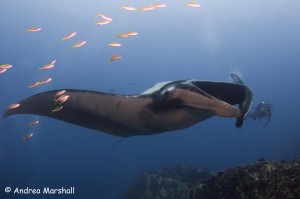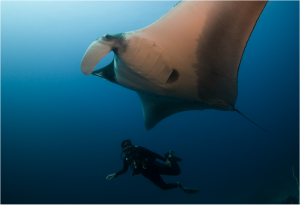In 2012, Journeys Within partnered with Ray of Hope for a “Culture and Conservation Tour” meant to educate first hand about the separate and shared passions of each organization. Led by regional expert, Andrea Ross (right) and marine biologist, Andrea Marshall (left), guests spent one week exploring the highlights of Myanmar and the one week diving among the manta rays and learning about their plight. Ross and Marshall’s venture raises the question, can tourism help save some of the world’s most vulnerable species?
International efforts to conserve some of the world’s largest and most fascinating underwater species got a major boost at a wildlife conference in Bangkok, Monday.
Five different species of sharks along with two species of rays received additional protection from the global community after stricter cross-border trade restrictions were adopted at the Convention on International Trade in Endangered Species of Wild Fauna and Flora (CITES).

Similar proposals to protect marine megafauna have failed to garner enough votes around the CITES table in the past. New support from South American and West African nations – along with a promise of cash from the EU – are the driving force to this week’s tipping point.
Some are hailing this move as a shift in paradigms; countries are now beginning to recognize that the economic value of saving these species can be greater than selling off dead individuals.
Marine Megafauna Foundation, an education, research and conservation body founded by one of the world’s foremost researchers of mantas, Dr Andrea Marshall, estimates that an individual manta ray can inject $1 million annually in tourism industry; ten times the amount that the dead animal’s much sought after gill rakers provide. Individual sharks are estimated to inject $800,000 into coastline tourism communities versus the few hundred dollars that the sharks bring in dead.
Visitors flocking to catch a glimpse at endangered animals undoubtedly brings about new problems — tourism dollars can be fickle and susceptible to trends, while animals tend to suffer under large crowds and human influences. These pressure can be predicted and mitigated in a way that protects the species.
While some may lament that these animals and the other endangered species still being discussed at CITES should be recognized for their intrinsic value — sharks are after all basically living fossils — viewing the animals as having more value alive than dead is a good start.
In some ways, developing sustainable, healthy and profitable tourism may be the only chance many of these endangered animals have.
Manta rays have faced drastic drops in populations as fishermen target the species for their gill rakers — a body part used in Chinese medicines.
“Manta rays are not a species that can afford to be exploited. [These new regulations are] desperately needed as a precautionary approach to avoid the over-exploitation of these species,” explains Marshall. “Those of us studying wild populations of manta rays are seeing first-hand substantial declines in their numbers across the globe. This is a real and pressing issue.”
A recently released paper in Marine Policy journal puts the number of sharks killed at an average of 100 million per year — or between 6 and 7 per cent of the overall populations. This practice is widely regarded as an unsustainable, leaving certain species at risk for extinction with unknown consequences to the overall ecosystem.
Should the initial decision not get overturned — the decisions could be reopened for debate at the final plenary session of the summit — governments will have to start abiding by the new restriction within 18 months. Obviously there is a long way to go from policy to action, but for many who have spent their lives working to save these magnificent beasts, this could be the moment where the tides begin to turn in their favour.
What exactly do the new protections mean?
The listing on CITES Appendix II — the classification for the protections granted this week — means that any countries exporting those animals listed would need to prove that the catches came from sustainable and legal stocks.
According to CITES, “International trade in specimens of Appendix-II species may be authorized by the granting of an export permit or re-export certificate. Permits or certificates should only be granted if the relevant authorities are satisfied that certain conditions are met, above all that trade will not be detrimental to the survival of the species in the wild.”
While wealthier countries like Australia and the U.S. can afford separate oceanic monitoring and enforcement to protect endangered populations, developing countries tend to rely on customs and regular law-enforcement. The new listing is meant to give those bodies additional powers to limit what is exported thereby helping curb the trade of endangered species.
Who is CITES?
Founded 40 years ago, the convention aims to afford varying degrees of protection to the world’s plant and animal species that are subject to international trade.
“Its aim is to ensure that international trade in specimens of wild animals and plants does not threaten their survival.” – CITES website
According to the CITES website, there are 177 member countries from all over the globe.
Want more details on what the CITES conference is all about? Here is Prince William giving the low-down.… Read more »




